BigQuery (via Collector method) - v3.0.0
About Collectors
Collectors are extractors that are developed and managed by you (A customer of K).
KADA provides python libraries that customers can use to quickly deploy a Collector.
Why you should use a Collector
There are several reasons why you may use a collector vs the direct connect extractor:
You are using the KADA SaaS offering and it cannot connect to your sources due to firewall restrictions
You want to push metadata to KADA rather than allow it pull data for Security reasons
You want to inspect the metadata before pushing it to K
Using a collector requires you to manage
Deploying and orchestrating the extract code
Managing a high water mark so the extract only pull the latest metadata
Storing and pushing the extracts to your K instance.
Pre-requisites
Collector Server Minimum Requirements
For the collector to operate effectively, it will need to be deployed on a server with the below minimum specifications:
CPU: 2 vCPU
Memory: 8GB
Storage: 30GB (depends on historical data extracted)
OS: unix distro e.g. RHEL preferred but can also work with Windows Server.
Python 3.10.x or later
Access to K landing directory
BigQuery Requirements
Access to BiqQuery
Step 1: Establish BigQuery Access
This step is performed by the Google Cloud Admin
Create a Service Account by going to the Google Cloud Admin or clicking on this link
Give the Service Account a name (e.g. KADA BQ Integration)
Select the Projects that include the BigQuery instance(s) that you want to catalog
Click Save
Create a Service Token
Click on the Service Account

Select the Keys tab. Click on Create new key
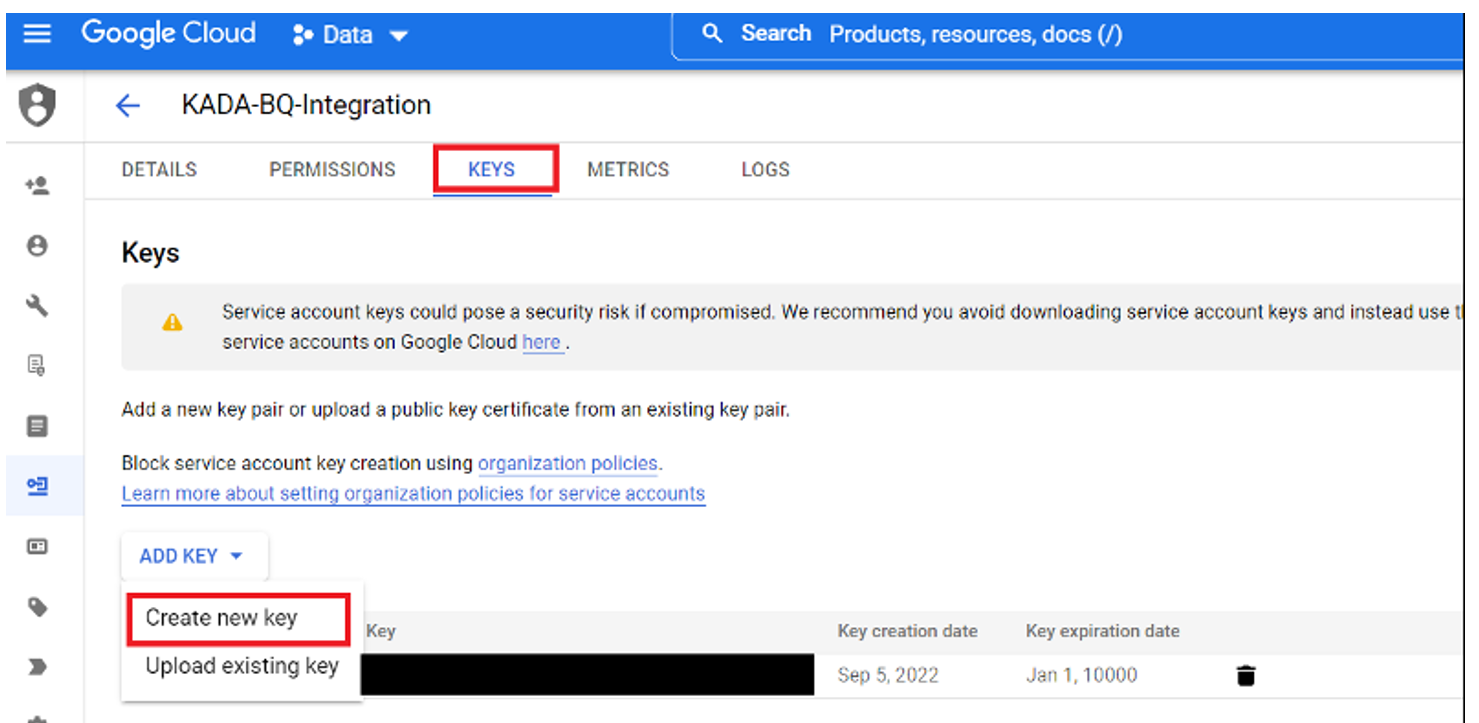
Select the JSON option. After clicking ‘CREATE’, the JSON file will automatically download to your device. Provide this to the user(s) that will complete the next steps
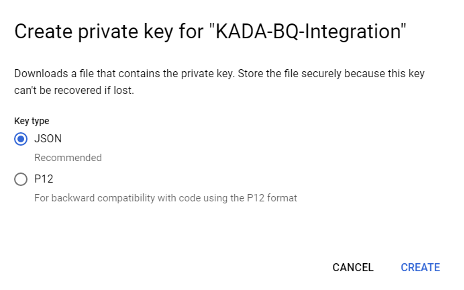
Add permission grants on the Service Account by going to IAM page or clicking on this link
Click on ADD
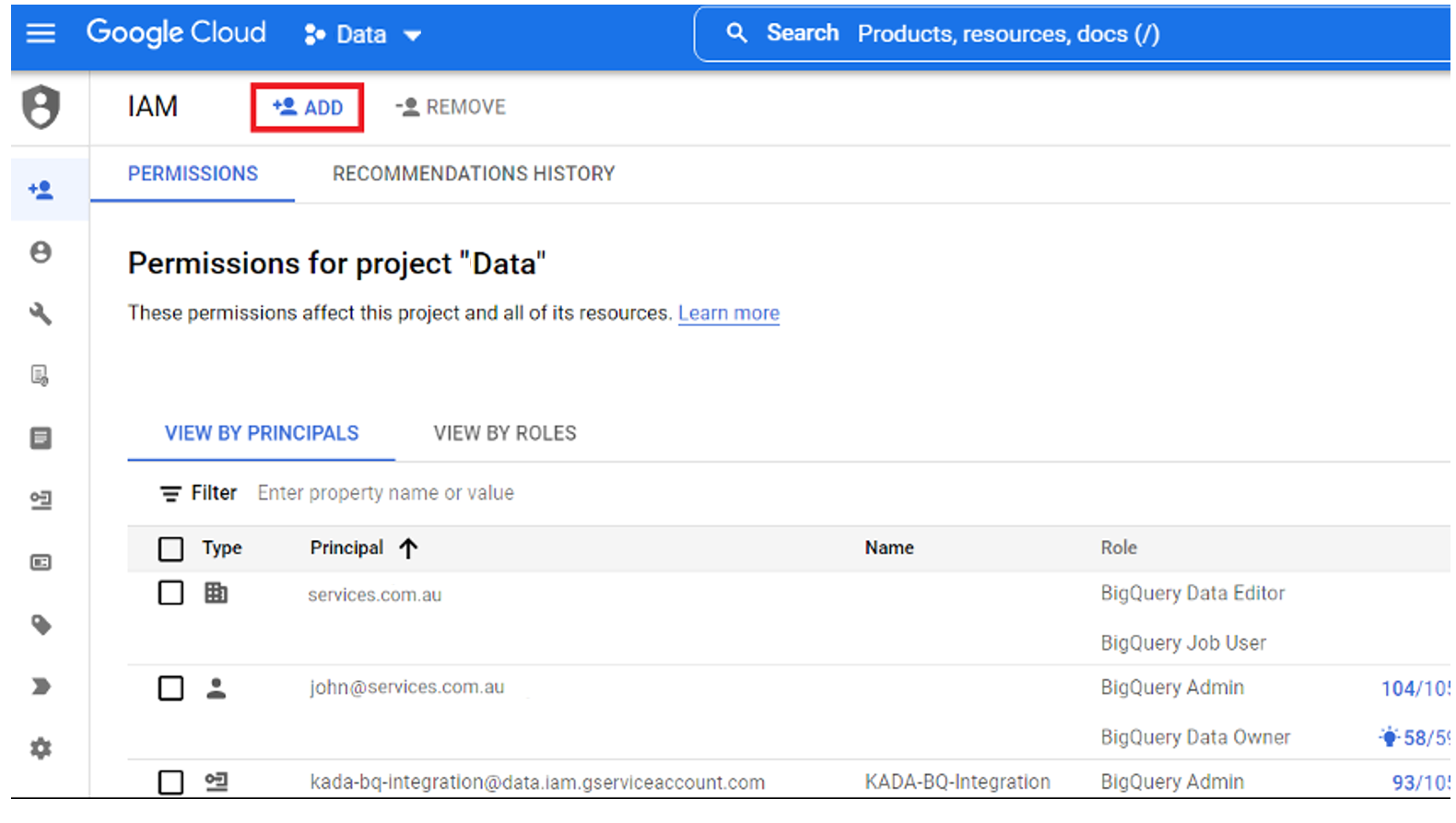
Add the Service Account to the ‘New principals’ field.
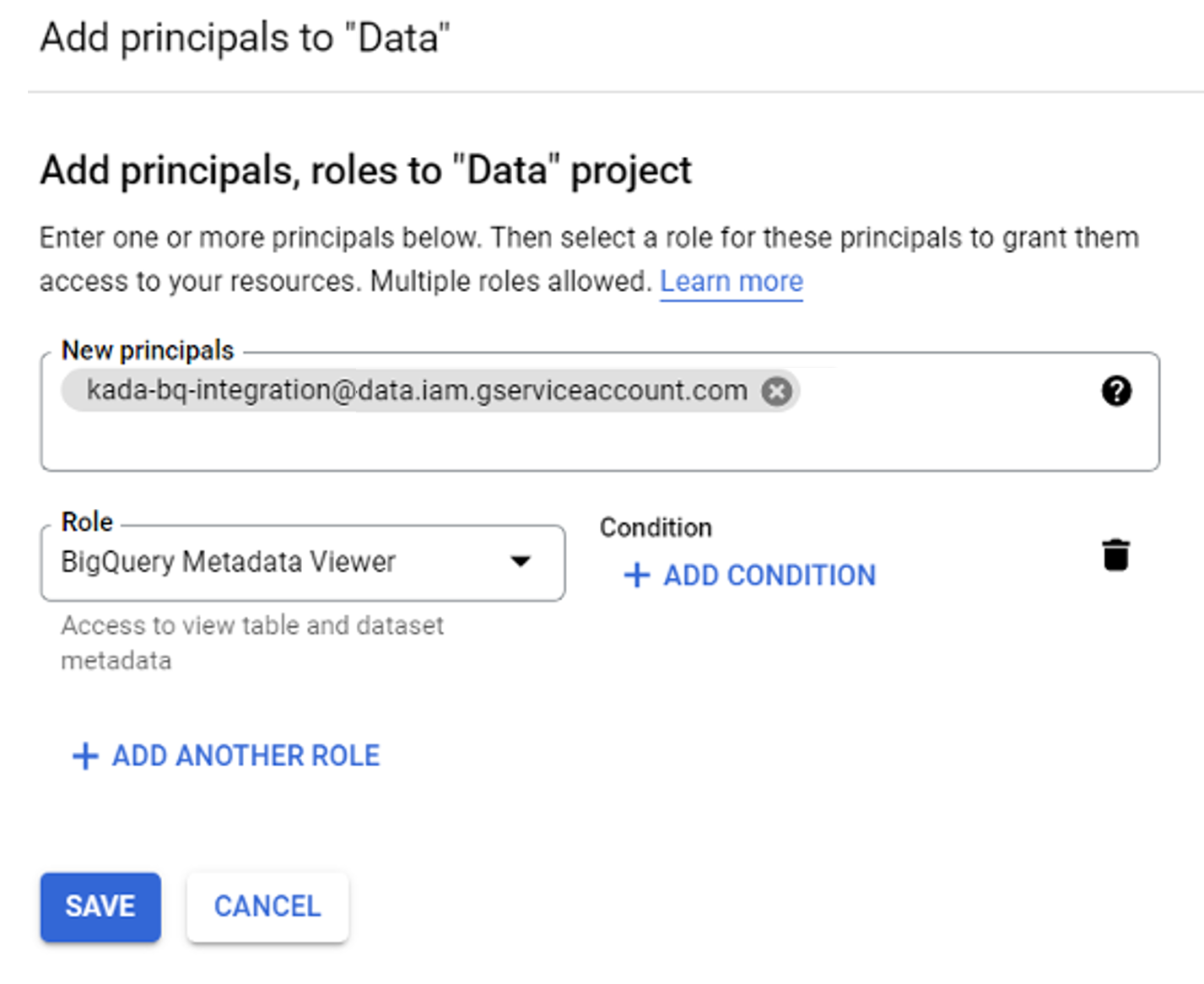
Grant the following roles this principal as shown in the following screenshot.
BigQuery Job User
BigQuery Metadata Viewer
BigQuery Read Session User
BigQuery Resource Viewer

Click SAVE
Step 2: Create the Source in K
Create a BigQuery source in K
Go to Settings, Select Sources and click Add Source
Select “Load from File system” option

Give the source a Name - e.g. BigQuery Production
Add the Host name for the BigQuery Server
Click Finish Setup
Step 3: Getting Access to the Source Landing Directory
When using a Collector you will push metadata to a K landing directory.
To find your landing directory you will need to
Go to Platform Settings - Settings. Note down the value of this setting
If using Azure: storage_azure_storage_account
if using AWS:
storage_root_folder - the AWS s3 bucket
storage_aws_region - the region where the AWS s3 bucket is hosted
Go to Sources - Edit the Source you have configured. Note down the landing directory in the About this Source section
To connect to the landing directory you will need
If using Azure: a SAS token to push data to the landing directory. Request this from KADA Support (support@kada.ai)
if using AWS:
an Access key and Secret. Request this from KADA Support (support@kada.ai)
OR provide your IAM role to KADA Support to provision access.
Step 4: Install the Collector
It is recommended to use a python environment such as pyenv or pipenv if you are not intending to install this package at the system level.
Some python packages also have dependencies on the OS level packages, so you may be required to install additional OS packages if the below fails to install.
You can download the Latest Core Library and whl via Platform Settings → Sources → Download Collectors
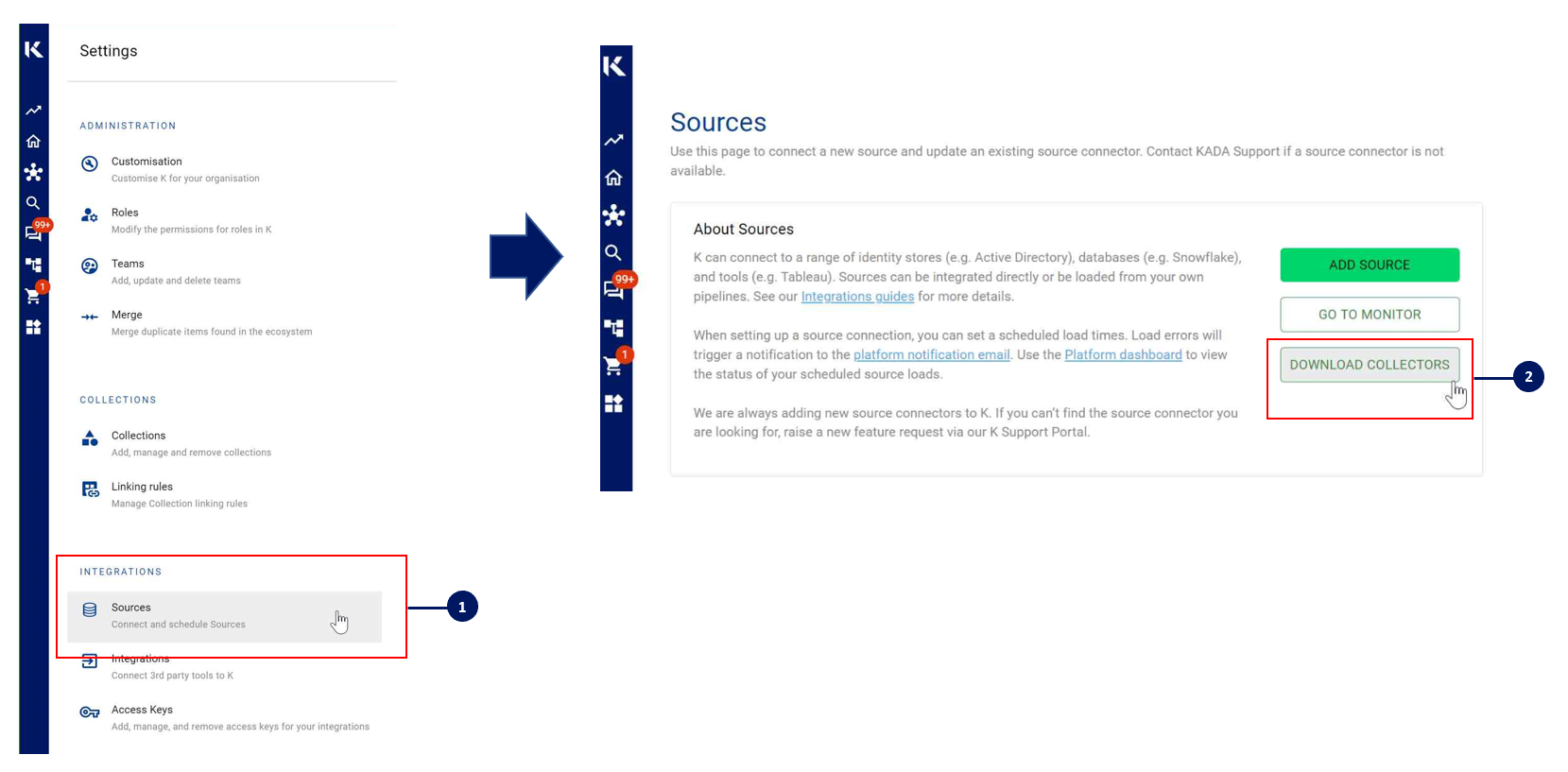
Run the following command to install the collector
pip install kada_collectors_extractors_<version>-none-any.whlYou will also need to install the common library kada_collectors_lib for this collector to function properly.
pip install kada_collectors_lib-<version>-none-any.whlUnder the covers this uses the BigQuery Client API and may have OS dependencies see https://cloud.google.com/bigquery/docs/reference/libraries
Step 5: Configure the Collector
The collector requires a set of parameters to connect to and extract metadata from BigQuery
FIELD | FIELD TYPE | DESCRIPTION | EXAMPLE |
|---|---|---|---|
regions | list<string> | List of valid regions to inspect against for data, see https://cloud.google.com/bigquery/docs/locations for list of valid regions | “us” |
projects | list<string> | List of project ids to inspect across the regions specified | “kada-data” |
host | string | This is the host that was onboarded in K for BigQuery | “bigquery” |
json_credentials | JSON | See permissions section on how to download the credentials json to assign to this value |
CODE
|
output_path | string | Absolute path to the output location where files are to be written | “/tmp/output” |
mask | boolean | To enable masking or not | true |
compress | boolean | To gzip the output or not | true |
These parameters can be added directly into the run or you can use pass the parameters in via a JSON file.
KADA provides an out of the box script that reads a configuration JSON file and runs the extractor. Below is the configuration file.
kada_bigquery_extractor_config.json
{
"regions": [],
"projects": [],
"host": "",
"json_credentials": {},
"output_path": "/tmp/output",
"mask": true,
"compress": true
}Step 6: Run the Collector
The following code is an example of how to run the extractor. You may need to uplift this code to meet any code standards at your organisation.
This can be executed in any python environment where the whl has been installed. It will produce and read a high water mark file from the same directory as the execution called bigquery_hwm.txt and produce files according to the configuration JSON.
This is the wrapper script: kada_bigquery_extractor.py
import os
import argparse
from kada_collectors.extractors.utils import load_config, get_hwm, publish_hwm, get_generic_logger
from kada_collectors.extractors.bigquery import Extractor
get_generic_logger('root') # Set to use the root logger, you can change the context accordingly or define your own logger
_type = 'bigquery'
dirname = os.path.dirname(__file__)
filename = os.path.join(dirname, 'kada_{}_extractor_config.json'.format(_type))
parser = argparse.ArgumentParser(description='KADA BigQuery Extractor.')
parser.add_argument('--config', '-c', dest='config', default=filename, help='Location of the configuration json, default is the config json in the same directory as the script.')
parser.add_argument('--name', '-n', dest='name', default=_type, help='Name of the collector instance.')
args = parser.parse_args()
start_hwm, end_hwm = get_hwm(args.name)
ext = Extractor(**load_config(args.config))
ext.test_connection()
ext.run(**{"start_hwm": start_hwm, "end_hwm": end_hwm})
publish_hwm(args.name, end_hwm)
Advance options:
If you wish to maintain your own high water mark files elsewhere you can use the above section’s script as a guide on how to call the extractor. The configuration file is simply the keyword arguments in JSON format. Refer to this document for more information Collector Integration General Notes | Storing-HWM-in-another-location
If you are handling external arguments of the runner yourself, you’ll need to consider additional items for the run method. Refer to this document for more information Collector Integration General Notes | The-run-method
from kada_collectors.extractors.bigquery import Extractor
kwargs = {my args} # However you choose to construct your args
hwm_kwrgs = {"start_hwm": "end_hwm": } # The hwm values
ext = Extractor(**kwargs)
ext.run(**hwm_kwrgs)class Extractor(regions: list = [], projects: list = [], host: str = 'bigquery', \
json_credentials: dict = {}, output_path: str = './output', mask: bool = False, \
compress: bool = False) -> Noneregions: The list of regions specified by user to extract
projects: The list of projects specified by user to extract
host: The host value onboarded in K
json_credentials: The json credentials for connection to BQ
sql: The list of SQL queries that will be executed by the program
output_path: full or relative path to where the outputs should go
mask: To mask the META/DATABASE_LOG files or not
compress: To gzip output files or not
Step 7: Check the Collector Outputs
K Extracts
A set of files (eg metadata, databaselog, linkages, events etc) will be generated. These files will appear in the output_path directory you set in the configuration details
High Water Mark File
A high water mark file is created in the same directory as the execution called bigquery_hwm.txt and produce files according to the configuration JSON. This file is only produced if you call the publish_hwm method.
If you want prefer file managed hwm, you can edit the location of the hwn by following these instructions Collector Integration General Notes | Storing-High-Water-Marks-(HWM)
Step 8: Push the Extracts to K
Once the files have been validated, you can push the files to the K landing directory.
You can use Azure Storage Explorer if you want to initially do this manually. You can push the files using python as well (see Airflow example below)
Example: Using Airflow to orchestrate the Extract and Push to K
The following example is how you can orchestrate the Tableau collector using Airflow and push the files to K hosted on Azure. The code is not expected to be used as-is but as a template for your own DAG.
# built-in
import os
# Installed
from airflow.operators.python_operator import PythonOperator
from airflow.models.dag import DAG
from airflow.operators.dummy import DummyOperator
from airflow.utils.dates import days_ago
from airflow.utils.task_group import TaskGroup
from plugins.utils.azure_blob_storage import AzureBlobStorage
from kada_collectors.extractors.utils import load_config, get_hwm, publish_hwm, get_generic_logger
from kada_collectors.extractors.tableau import Extractor
# To be configed by the customer.
# Note variables may change if using a different object store.
KADA_SAS_TOKEN = os.getenv("KADA_SAS_TOKEN")
KADA_CONTAINER = ""
KADA_STORAGE_ACCOUNT = ""
KADA_LANDING_PATH = "lz/tableau/landing"
KADA_EXTRACTOR_CONFIG = {
"server_address": "http://tabserver",
"username": "user",
"password": "password",
"sites": [],
"db_host": "tabserver",
"db_username": "repo_user",
"db_password": "repo_password",
"db_port": 8060,
"db_name": "workgroup",
"meta_only": False,
"retries": 5,
"dry_run": False,
"output_path": "/set/to/output/path",
"mask": True,
"mapping": {}
}
# To be implemented by the customer.
# Upload to your landing zone storage.
# Change '.csv' to '.csv.gz' if you set compress = true in the config
def upload():
output = KADA_EXTRACTOR_CONFIG['output_path']
for filename in os.listdir(output):
if filename.endswith('.csv'):
file_to_upload_path = os.path.join(output, filename)
AzureBlobStorage.upload_file_sas_token(
client=KADA_SAS_TOKEN,
storage_account=KADA_STORAGE_ACCOUNT,
container=KADA_CONTAINER,
blob=f'{KADA_LANDING_PATH}/{filename}',
local_path=file_to_upload_path
)
with DAG(dag_id="taskgroup_example", start_date=days_ago(1)) as dag:
# To be implemented by the customer.
# Retrieve the timestamp from the prior run
start_hwm = 'YYYY-MM-DD HH:mm:SS'
end_hwm = 'YYYY-MM-DD HH:mm:SS' # timestamp now
ext = Extractor(**KADA_EXTRACTOR_CONFIG)
start = DummyOperator(task_id="start")
with TaskGroup("taskgroup_1", tooltip="extract tableau and upload") as extract_upload:
task_1 = PythonOperator(
task_id="extract_tableau",
python_callable=ext.run,
op_kwargs={"start_hwm": start_hwm, "end_hwm": end_hwm},
provide_context=True,
)
task_2 = PythonOperator(
task_id="upload_extracts",
python_callable=upload,
op_kwargs={},
provide_context=True,
)
# To be implemented by the customer.
# Timestamp needs to be saved for next run
task_3 = DummyOperator(task_id='save_hwm')
end = DummyOperator(task_id='end')
start >> extract_upload >> end